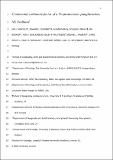Files in this item
Continental carbonate facies of a Neoproterozoic panglaciation, north-east Svalbard
Item metadata
| dc.contributor.author | Fairchild, Ian J. | |
| dc.contributor.author | Fleming, Edward J. | |
| dc.contributor.author | Bao, Huiming | |
| dc.contributor.author | Benn, Douglas I. | |
| dc.contributor.author | Boomer, Ian | |
| dc.contributor.author | Dublyansky, Yuri V. | |
| dc.contributor.author | Halverson, Galen P. | |
| dc.contributor.author | Hambrey, Michael J. | |
| dc.contributor.author | Hendy, Chris | |
| dc.contributor.author | McMillan, Emily A. | |
| dc.contributor.author | Spötl, Christoph | |
| dc.contributor.author | Stevenson, Carl T. E. | |
| dc.contributor.author | Wynn, Peter M. | |
| dc.date.accessioned | 2017-02-05T00:32:42Z | |
| dc.date.available | 2017-02-05T00:32:42Z | |
| dc.date.issued | 2016-02 | |
| dc.identifier | 241163216 | |
| dc.identifier | 98dc5e8c-5383-4879-b856-9a061e588f10 | |
| dc.identifier | 84957678533 | |
| dc.identifier | 000372268900007 | |
| dc.identifier.citation | Fairchild , I J , Fleming , E J , Bao , H , Benn , D I , Boomer , I , Dublyansky , Y V , Halverson , G P , Hambrey , M J , Hendy , C , McMillan , E A , Spötl , C , Stevenson , C T E & Wynn , P M 2016 , ' Continental carbonate facies of a Neoproterozoic panglaciation, north-east Svalbard ' , Sedimentology , vol. 63 , no. 2 , pp. 443-497 . https://doi.org/10.1111/sed.12252 | en |
| dc.identifier.issn | 1365-3091 | |
| dc.identifier.other | Bibtex: urn:9a0f5591f80d99c668c31967436d6375 | |
| dc.identifier.other | ORCID: /0000-0002-3604-0886/work/64697404 | |
| dc.identifier.uri | https://hdl.handle.net/10023/10231 | |
| dc.description | The fieldwork and subsequent analyses were funded by Natural Environment Research Council grant GR3/NE/H004963/1 within project GAINS (Glacial Activity In Neoproterozoic Svalbard). | en |
| dc.description.abstract | The Marinoan panglaciation (ca 650 to 635 Ma) is represented in north-east Svalbard by the 130 to 175 m thick Wilsonbreen Formation which contains syn-glacial carbonates in its upper 100 m. These sediments are now known to have been deposited under a CO2-rich atmosphere, late in the glaciation, and global climate models facilitate testing of proposed analogues. Precipitated carbonates occur in four of the seven facies associations identified: Fluvial Channel (including stromatolitic and intraclastic limestones in ephemeral stream deposits); Dolomitic Floodplain (dolomite-cemented sand and siltstones, and microbial dolomites); Calcareous Lake Margin (intraclastic dolomite and wave-rippled or aeolian siliciclastic facies); and Calcareous Lake (slump-folded and locally re-sedimented rhythmic/stromatolitic limestones and dolomites associated with ice-rafted sediment). There is no strong cyclicity, and modern analogues suggest that sudden changes in lake level may exert a strong control on facies geometry. Both calcite and dolomite in stromatolites and rhythmites display either primary or early diagenetic replacive growth. Oxygen isotope values (−12 to +15‰VPDB) broadly covary with δ13C. High δ13C values of +3·5 to +4·5‰ correspond to equilibration with an atmosphere dominated by volcanically degassed CO2 with δ13C of −6 to −7‰. Limestones have consistently negative δ18O values, while rhythmic and playa dolomites preserve intermediate compositions, and dolocretes possess slightly negative to strongly positive δ18O signatures, reflecting significant evaporation under hyperarid conditions. Inferred meltwater compositions (−8 to −15·5‰) could reflect smaller Rayleigh fractionation related to more limited cooling than in modern polar regions. A common pseudomorph morphology is interpreted as a replacement of ikaite (CaCO3·H2O), which may also have been the precursor for widespread replacive calcite mosaics. Local dolomitization of lacustrine facies is interpreted to reflect microenvironments with fluctuating redox conditions. Although differing in (palaeo)latitude and carbonate abundance, the Wilsonbreen carbonates provide strong parallels with the McMurdo Dry Valleys of Antarctica. | |
| dc.format.extent | 720264 | |
| dc.language.iso | eng | |
| dc.relation.ispartof | Sedimentology | en |
| dc.subject | Carbon isotopes | en |
| dc.subject | Cryogenian | en |
| dc.subject | Ikaite pseudomorphs | en |
| dc.subject | Lacustrine | en |
| dc.subject | Oxygen isotopes | en |
| dc.subject | Snowball Earth | en |
| dc.subject | DAS | en |
| dc.subject | SDG 13 - Climate Action | en |
| dc.title | Continental carbonate facies of a Neoproterozoic panglaciation, north-east Svalbard | en |
| dc.type | Journal article | en |
| dc.contributor.institution | University of St Andrews. Geography & Sustainable Development | en |
| dc.contributor.institution | University of St Andrews. Bell-Edwards Geographic Data Institute | en |
| dc.identifier.doi | 10.1111/sed.12252 | |
| dc.description.status | Peer reviewed | en |
| dc.date.embargoedUntil | 2017-02-04 |
This item appears in the following Collection(s)
Items in the St Andrews Research Repository are protected by copyright, with all rights reserved, unless otherwise indicated.

